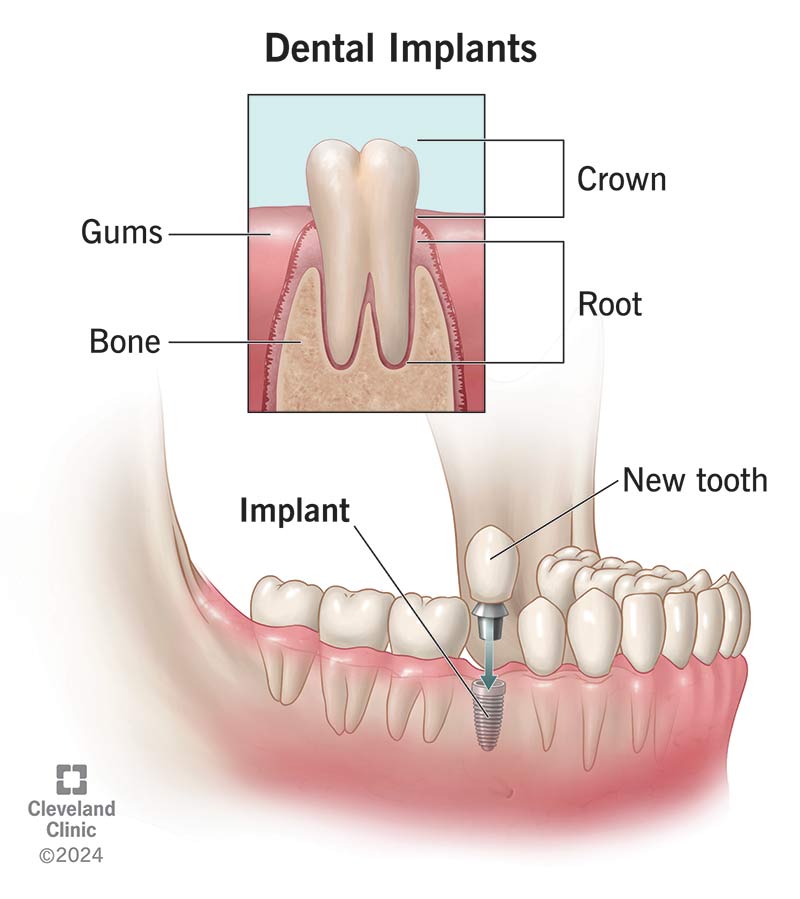Get This Report about Dental Implants
Table of ContentsThings about Dental ImplantsFascination About Dental ImplantsRumored Buzz on Dental Implants3 Simple Techniques For Dental Implants
are medical gadgets surgically implanted right into the jaw to bring back a person's ability to eat or their appearance. They supply support for man-made (phony) teeth, such as crowns, bridges, or dentures. When a tooth is lost because of injury or illness, a person can experience problems such as rapid bone loss, malfunctioning speech, or changes to chewing patterns that cause discomfort.
Structure of The Oral Implant System picking dental implants, speak to your dental copyright regarding the possible advantages and risks, and whether you are a prospect for the procedure. Points to take into consideration: Your general wellness is an important factor in figuring out whether you are an excellent prospect for dental implants, the length of time it will require to recover, and how much time the implant might stay in place.
Cigarette smoking may impact the healing process and reduce the long-term success of the implant. The recovery process for the implant body might take several months or longer, throughout which time you commonly have a short-term abutment instead of the tooth. the oral implant treatment: Meticulously follow the oral hygiene guidelines given to you by your dental provider.
Some Known Details About Dental Implants
Implant failure can cause the demand for one more procedure to deal with or replace the dental implant system. Recovers the capacity to eat Recovers cosmetic appearance Helps maintain the jawbone from reducing because of bone loss Preserves the health and wellness of the surrounding bone and gums Aids keep adjacent (neighboring) teeth steady Improves high quality of life Damages to surrounding natural teeth during dental implant placement Injury to the surrounding cells during surgical procedure, such as sinus opening Injury throughout surgical treatment (as an example, crack of surrounding jawbone) Insufficient feature, such as seeming like the teeth do not bite together normally A sensation that the tooth hangs or turning in place arising from an abutment screw loosening Implant body failing (looseness of the dental implant body) because of systemic infection, which may be more probable in individuals with unchecked diabetics issues as a result of local infection in bone and gum tissues sustaining the implant body because of delayed healing, which might be a lot more likely in clients who smoke Problem cleaning up the gums around the dental implant, resulting in inadequate dental health Without treatment gum disease Post-surgical tingling due to nerve impingement or damage Always notify health and wellness treatment suppliers and imaging technicians that you have oral implants prior to any magnetic resonance imaging (MRI) or x-ray procedures.
FDA is not conscious of any negative events reported for MRI or x-ray procedures with oral implants. Oral implants systems are generally constructed from materials that follow international consensus standards of the International Organization for Standardization (ISO) or ASTM International. These criteria have details of what makes a secure product.
Various other products such as gold alloys, cobalt-based alloys, titanium alloys, or ceramic materials are in some cases used. The security accounts of these products are widely known. Oral implant systems are reviewed according to international agreement requirements. Biocompatibility testing, to reveal that bodily contact with the gadget does not trigger issues like inflammation or allergy, belongs to the evaluation that aids make sure the products in the oral implant system are safe and do not trigger damaging effects when dental implanted in people.

The Definitive Guide to Dental Implants
Some people are not eligible for dental implant surgical treatment. It is for dental doctors to operate on people with: intense illnessuncontrollable metabolic diseasebone or soft tissue disease or infectionIf these problems are settled, an individual can have the surgery. Dental Implants. In, dental doctors avoid why not try here operating individuals with: If individuals with any one of the above undertake oral implant surgery, there is a higher threat of the implant falling short
Some individuals have a jawbone abnormality that protects against enough bone for a dental implant from establishing. In such situations, a cosmetic surgeon might need to carry out a ridge adjustment. This includes raising the periodontal to reveal the area of warped bone. The specialist will then utilize a bone or bone replacement to fix and accumulate the location.
Dental dental implant surgical treatment is an individualized procedure. It's not the same for every person. The complying with provides a basic summary of what you can expect your dental expert, oral doctor, periodontist or prosthodontist to do: Position the dental implant surgically. Offer you time to heal. Affix the post and last crown, bridge or denture.
Next off, your specialist will very carefully put the oral implant into your jaw. Finally, your surgeon will reposition your gum tissues and shut the laceration see here with stitches. If your dental implant is near the front of your mouth, your dental practitioner will certainly make a momentary tooth for you to use till you recover. That means, you will not have a void in your smile while you recuperate.
Dental Implants Fundamentals Explained
Your company can inform you what to expect in your circumstance. Throughout the healing stage, your jawbone must fuse to the oral implant. This process, called osseointegration, is crucial for security and long-lasting success. This procedure can take anywhere from three to 9 months. In some instances, it might take longer.
Once your implant heals, your dental practitioner can affix the joint (little port post) and your last reconstruction (crown, bridge or denture). This typically takes concerning one hour to complete and may need a 2nd small surgical treatment. You should not feel any discover this info here type of pain throughout your oral implant procedure due to the fact that your service provider will use medication to numb your periodontals.